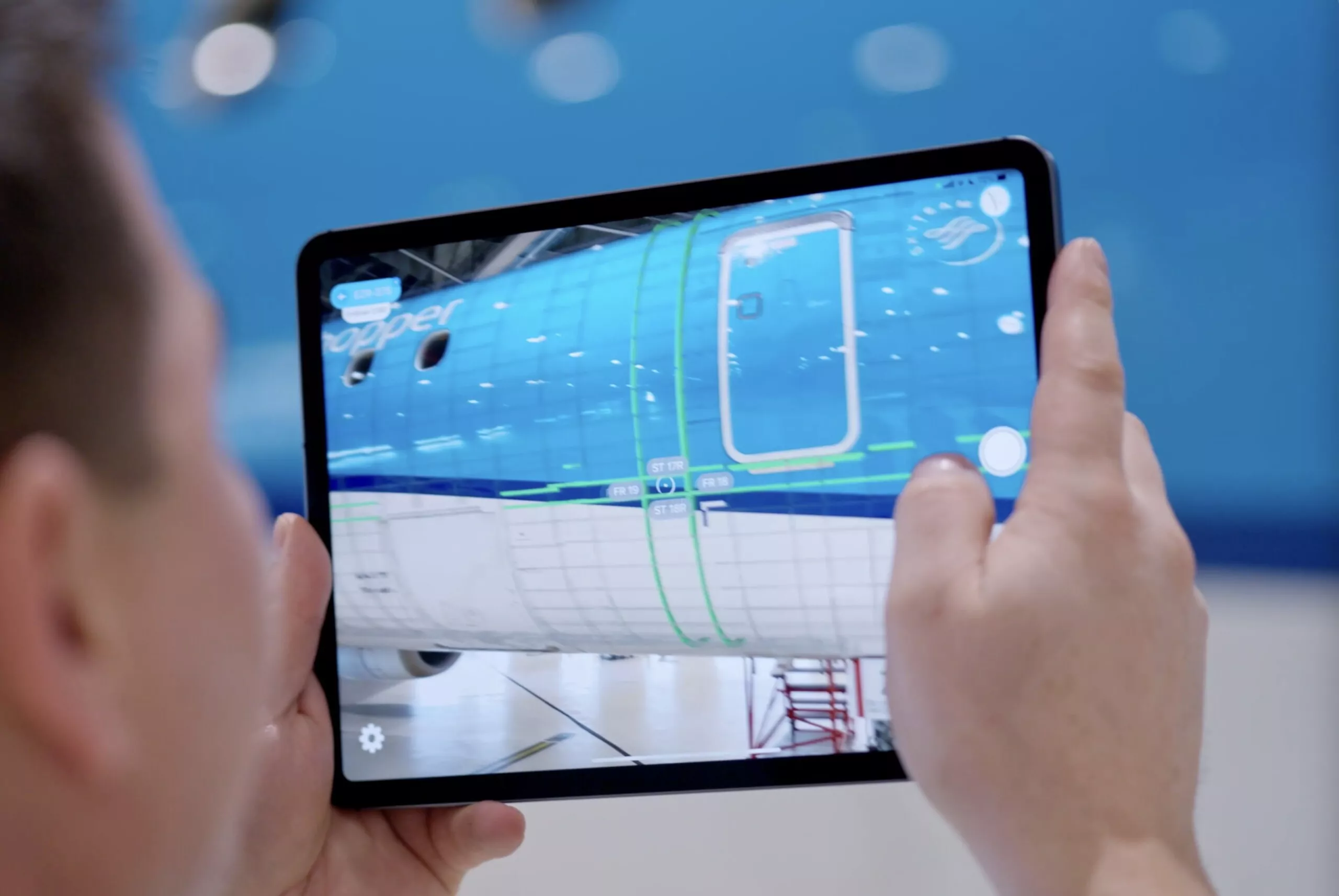
September 26, 2023
Flight delays are a frustrating aspect of flying. It’s a situation most can relate to: sitting in the terminal or on the tarmac wondering why your flight is delayed, with no answers or information.
There are dozens of reasons why an aircraft could be delayed with safety being the underpinning reason for many of them. Suppose an aircraft incurs minor damage from a lightning strike or by coming into contact with ground equipment as it’s being towed or refueled, or it sustains damage from an in-flight collision with a bird or inclement weather. In these cases, the aircraft must undergo inspection before it can fly again. The aviation industry faces significant challenges regarding timely pre-flight damage checks, and these delays are a common pain point for airlines and passengers alike.
The process of ensuring an aircraft is safe to fly is an unavoidable, time-consuming task. Imagine a scenario where the baggage handling equipment accidentally collides with the plane, causing damage to the fuselage. Ground engineers must inspect the damage, determine its precise location, depth and extent, and decide if the craft is still airworthy. Aircraft safety is a highly regulated process and an industry requirement, and every major part of an aircraft has a serial number that is tracked and assessed for airworthiness. This manual inspection—which includes recording the damage and documenting the process—can take more than 30 minutes, causing substantial delays and disruptions to flight schedules.
New technologies speed up pre-flight damage checks
Regional Jet Center (RJC) is a dedicated maintenance, repair and overhaul organization of the Air France-KLM Group. In partnership with IBM, RJC developed an aircraft damage assessment solution using augmented reality and digital twin technology—core processes of spatial computing—to revolutionize pre-flight damage checks.
Spatial computing blends the physical and digital world, using augmented reality, virtual reality or real-time 3D technologies. As enterprise use of mobile devices grows, spatial computing offers organizations a way to benefit more from investments in smartphones, tablets and headsets. Airlines can use this technology to enhance ground engineers’ decision-making by providing a more immersive and interactive experience. In the context of airline safety, spatial computing allows for more efficient and accurate damage inspections, drastically reducing the time required to complete the process effectively.
Using a specialized application called Damage Assessment designed for iPads, technicians can use augmented reality to enhance their inspections of the aircraft. This application uses the digital twin of the plane to map the aircraft frame onto the actual aircraft in real time so that the inspectors can pinpoint exactly where the damage is located. With Damage Assessment, a) inspectors can precisely identify and assess damage, significantly speeding up the inspection process; b) ground engineers can pull up relevant damage history and engineering documentation to support the assessment process; and c) inspection times can be reduced from 30 minutes to 3 minutes (a remarkable 900% improvement in efficiency).
Down the road, AI can further assist by providing recommended actions to further expedite the process. Reducing the time to review and record new damage with secure data-backed digital tools increases reporting accuracy in a highly regulated industry, leading to safer flights. This innovative solution also ensures the accuracy and integrity of inspection data. Inspections are often recorded manually on paper, leading to potential errors and data loss. With spatial computing, all inspection data is seamlessly integrated into the digital twin of the aircraft, creating a transparent and traceable chain of information. Spatial computing enhances safety and simplifies compliance with industry regulations.
RJC and IBM’s spatial computing solution
While this technology is undoubtedly a game-changer for RJC, it’s worth noting that this is an industry-wide pain point. Airlines worldwide struggle with the inefficiencies of pre-flight damage checks. RJC’s spatial computing solution not only benefits their operations but can potentially transform airline safety practices globally.
In such a highly regulated industry, RJC must prove that a new process like this provides a marked result in both time and accuracy to be approved by industry regulators. RJC has started the process to get widespread industry adoption of this technology, making it possible for other airlines to use it. At the same time, IBM is seeking partnerships with organizations that invest in spatial computing technology.
IBM can assist professionals in the aviation industry, airline executives or any enterprise looking to adopt similar solutions or explore the possibilities of spatial computing for their unique challenges.
Learn more about RJC and IBM’s spatial computing solution and witness its potential in action. Attend the World Aviation Festival 26-28 September 2023 in Lisbon, Portugal, and be part of the journey toward safer and more efficient air travel.
Learn more about IBM solutions for travel & transportation
More from AI for the Enterprise

September 20, 2023
“Teams will get smarter and faster”: A conversation with Eli Manning
3 min read – For the last three years, IBM has worked with two-time champion Eli Manning to help spread the word about our partnership with ESPN. The nature of that partnership is pretty technical, involving powerful AI models—built with watsonx—that analyze massive data sets to generate insights that help ESPN Fantasy Football team owners manage their teams. Eli has not only helped us promote awareness of these insights, but also to unpack the technology behind them, making it understandable and accessible to millions.…
<!—->

September 20, 2023
What can AI and generative AI do for governments?
4 min read – Few technologies have taken the world by storm the way artificial intelligence (AI) has over the past few years. AI and its many use cases have become a topic of public discussion no longer relegated to tech experts. AI—generative AI, in particular—has tremendous potential to transform society as we know it for good, boost productivity and unlock trillions in economic value in the coming years. AI’s value is not limited to advances in industry and consumer products alone. When implemented in…
<!—->

September 19, 2023
Generative AI as a catalyst for change in the telecommunications industry
4 min read – Generative artificial intelligence (AI) burst into the mainstream in 2023, lighting a fire under businesses to integrate enterprise-grade versions into their processes. By 2024, 60% of C-suite executives are planning to pilot or operate generative AI in some way, indicating that generative AI’s public-facing platforms have awakened the world to its groundbreaking capabilities For Communications Service Providers (CSPs) and Network Equipment Providers (NEPs), in particular, generative AI holds tremendous potential to help improve all manner of operations and customer engagement.…
<!—->

September 18, 2023
How to establish secure AI+ business models
4 min read – Enterprise adoption of AI has doubled over the past five years, with CEOs today stating that they face significant pressure from investors, creditors and lenders to accelerate adoption of generative AI. This is largely driven by a realization that we’ve crossed a new threshold with respect to AI maturity, introducing a new, wider spectrum of possibilities, outcomes and cost benefits to society as a whole. Many enterprises have been reserved to go “all in” on AI, as certain unknowns within…
<!—->
- SEO Powered Content & PR Distribution. Get Amplified Today.
- PlatoData.Network Vertical Generative Ai. Empower Yourself. Access Here.
- PlatoAiStream. Web3 Intelligence. Knowledge Amplified. Access Here.
- PlatoESG. Carbon, CleanTech, Energy, Environment, Solar, Waste Management. Access Here.
- PlatoHealth. Biotech and Clinical Trials Intelligence. Access Here.
- Source: https://www.ibm.com/blog/spatial-computing-is-the-next-frontier-in-airline-flight-safety/
- :has
- :is
- :not
- :where
- $UP
- 1
- 12
- 13
- 19
- 20
- 2023
- 2024
- 26
- 28
- 29
- 30
- 300
- 39
- 3d
- 40
- 400
- 41
- 9
- a
- About
- accelerate
- accessible
- accuracy
- accurate
- Action
- actions
- actual
- adopt
- Adoption
- advances
- Advertising
- again
- AI
- AIR
- air travel
- aircraft
- airline
- Airlines
- alike
- All
- allows
- alone
- also
- amp
- an
- analytics
- analyze
- and
- answers
- any
- Application
- approved
- ARE
- article
- artificial
- artificial intelligence
- Artificial intelligence (AI)
- AS
- aspect
- assess
- assessed
- assessment
- assist
- At
- attend
- augmented
- Augmented Reality
- author
- aviation
- awareness
- b
- back
- BE
- become
- been
- before
- behind
- being
- benefit
- benefits
- bird
- blends
- Blog
- boost
- both
- business
- businesses
- but
- by
- C-suite
- called
- CAN
- capabilities
- carbon
- card
- Cards
- cases
- CAT
- Catalyst
- causing
- Center
- CEOs
- certain
- chain
- challenges
- champion
- change
- check
- Checks
- class
- collision
- color
- coming
- Common
- Communications
- complete
- compliance
- computing
- consumer
- Consumer products
- contact
- Container
- context
- continue
- Conversation
- Cost
- could
- craft
- Creating
- creditors
- Crossed
- CSS
- custom
- customer
- Customer Engagement
- damage
- data
- data loss
- data sets
- Date
- decide
- Decision Making
- dedicated
- Default
- definitions
- Delayed
- delays
- depth
- description
- designed
- Determine
- developed
- Devices
- digital
- digital twin
- digital world
- discussion
- disruptions
- do
- documentation
- documenting
- doubled
- dozens
- drastically
- driven
- Economic
- economic value
- effectively
- efficiency
- efficient
- engagement
- Engineering
- Engineers
- enhance
- Enhances
- ensures
- ensuring
- Enter
- Enterprise
- enterprise-grade
- enterprises
- equipment
- Errors
- ESPN
- establish
- Ether (ETH)
- Every
- exactly
- executives
- Exit
- expedite
- experience
- experts
- explore
- extent
- Face
- faces
- FANTASY
- few
- Fire
- five
- flight
- Flights
- flying
- follow
- fonts
- Football
- For
- FRAME
- from
- Frontier
- frustrating
- further
- game-changer
- generate
- generative
- Generative AI
- generator
- get
- Globally
- Go
- good
- Governments
- Grid
- Ground
- groundbreaking
- Group
- Grows
- Handling
- Have
- headsets
- height
- help
- helped
- highly
- history
- holds
- How
- How To
- HTTPS
- IBM
- ICO
- ICON
- identify
- if
- image
- imagine
- immersive
- implemented
- improve
- improvement
- in
- includes
- Increases
- index
- indicating
- industry
- information
- innovative
- insights
- integrate
- integrated
- integrity
- Intelligence
- interactive
- into
- introducing
- Invest
- Investments
- Investors
- involving
- iOS
- IT
- ITS
- journey
- jpg
- Know
- large
- largely
- Last
- leading
- lenders
- Lighting
- lightning
- like
- Limited
- Lisbon
- locale
- located
- location
- longer
- looking
- loss
- Mainstream
- maintenance
- major
- Making
- manage
- manner
- manual
- manually
- many
- map
- marked
- massive
- maturity
- max-width
- millions
- min
- minor
- minutes
- Mobile
- mobile devices
- models
- more
- more efficient
- most
- must
- Nature
- Navigation
- network
- network equipment
- New
- next
- no
- nothing
- noting
- number
- of
- Offers
- often
- on
- only
- operate
- Operations
- optimized
- or
- organization
- organizations
- Other
- our
- outcomes
- over
- Overhaul
- owners
- page
- Pain
- Paper
- part
- particular
- Partnership
- partnerships
- past
- PHP
- physical
- pilot
- plane
- planning
- Platforms
- plato
- Plato Data Intelligence
- PlatoData
- plugin
- Point
- policy
- Portugal
- position
- possibilities
- possible
- Post
- potential
- potentially
- powerful
- practices
- precise
- precisely
- pressure
- pretty
- process
- processes
- productivity
- Products
- professionals
- promote
- Prove
- providers
- provides
- providing
- public
- Reading
- real
- real-time
- Reality
- realization
- reason
- reasons
- recommended
- record
- recorded
- recording
- Reduced
- reduces
- reducing
- regarding
- regulated
- regulations
- Regulators
- relevant
- remarkable
- repair
- Reporting
- required
- requirement
- reserved
- respect
- responsive
- result
- review
- revolutionize
- road
- robots
- Rogers
- s
- safe
- safer
- Safety
- same
- scenario
- Screen
- scripts
- seamlessly
- secure
- seeking
- seo
- September
- September 19
- serial
- service
- service providers
- Sets
- significant
- significantly
- similar
- site
- Sitting
- situation
- small
- smarter
- smartphones
- So
- Society
- solution
- Solutions
- some
- Spatial
- spatial computing
- specialized
- Spectrum
- speed
- Sponsored
- spread
- start
- started
- stating
- Still
- Storm
- strike
- Struggle
- substantial
- such
- support
- Take
- taken
- Task
- team
- teams
- tech
- Technical
- Technologies
- Technology
- telecommunications
- Terminal
- than
- that
- The
- the world
- their
- Them
- theme
- These
- they
- this
- three
- threshold
- time
- time-consuming
- timely
- times
- Title
- to
- today
- tools
- top
- topic
- toward
- traceable
- Transform
- transparent
- travel
- tremendous
- trillions
- twin
- type
- under
- undergo
- underpinning
- understandable
- undoubtedly
- unique
- unlock
- URL
- us
- use
- uses
- using
- value
- Virtual
- Virtual reality
- W
- Way..
- we
- Weather
- What
- whole
- why
- wider
- widespread
- will
- with
- witness
- wondering
- Word
- WordPress
- worked
- world
- worldwide
- worth
- written
- years
- Your
- zephyrnet












